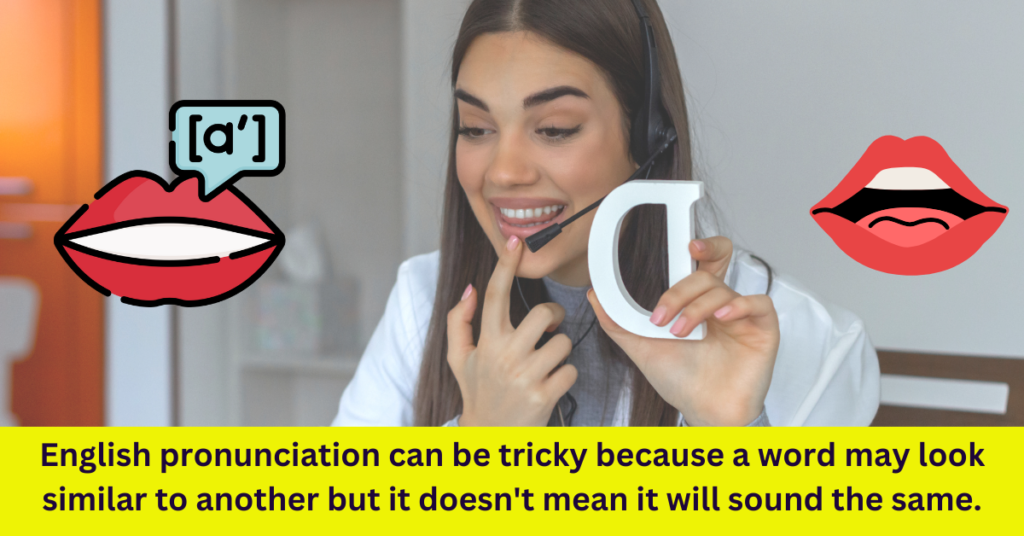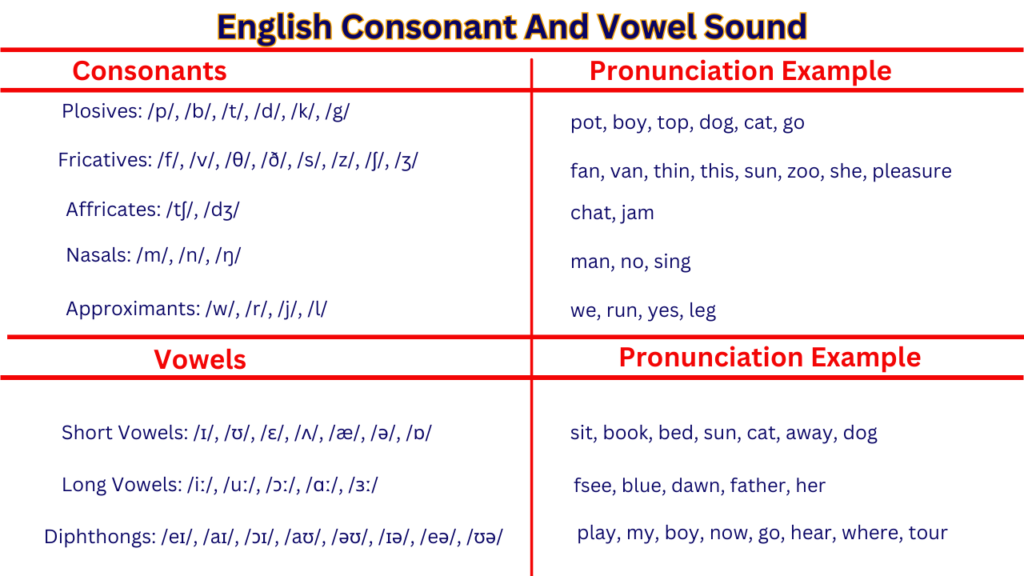English Pronunciation Tips for Non-Native Speakers: Fix Common Mistakes

Introduction:
Welcome to ‘Master English with Sonika’! In this inaugural post, we embark on an exciting journey into the world of English pronunciation. Many non-native speakers of English come across different pronunciation challenges. Understanding and mastering challenging English sounds is crucial for improving overall English fluency.

Why English Pronunciation Matters:
English pronunciation is vital for conveying precise meaning. It helps us express ourselves fully and aids in connecting with others. Whether in daily conversations or professional presentations, clear and accurate pronunciation improves comprehension and promotes effective communication. Additionally, mastering Correct English pronunciation paves way for numerous opportunities, in academic, professional, and personal contexts.
The Sounds of English:
English is a rich, evolving and universally known language. Also, it features a variety of sounds and phonetic patterns. From consonants and vowels to diphthongs and schwas, every sound adds to the intricate meaning of English pronunciation. Therefore, grasping these sounds and their symbols is essential for achieving accurate pronunciation and effective verbal communication for non-native speakers.
Common Pronunciation Challenges:
English pronunciation poses distinct challenges for non-native speakers. For example, issues like silent letters, irregular spellings, homophones, and regional accents can make mastering English pronunciation seem overwhelming. However, with patience, practice, and determination, non-native speakers can overcome these obstacles and achieve proficiency in English pronunciation.
Getting Started:
Many non-native speakers of English have to face significant pronunciation challenges on the way to gaining proficiency in English. Understanding and mastering difficult English sounds is crucial for improving overall English fluency. Whether you are starting out or looking to enhance your English skills, numerous resources and strategies are at your disposal to help you achieve your English pronunciation goals. From online courses and pronunciation guides to language exchange partners and speech recognition tools, suggesting the methods that work best for you, is essential for success. Also, continuous practice is required to achieve utmost clarity, in speech.
We can categorize English language sounds into consonant sounds and vowel sounds. One can create these sounds through different articulatory positions. Thorough understanding of producing these sounds is essential, for clear speech. Join me as I delve deeper into the fascinating world of English pronunciation, one sound category at a time.

Let’s explore each category in detail:
Consonant Sounds:
1. Place of Articulation:
- Bilabial: Sounds produced using both lips, such as /p/, /b/, and /m/.
- Labiodental: Sounds produced with the lower lip against the upper teeth, such as /f/ and /v/.
- Dental: Sounds produced with the tongue against the teeth, like the initial sound of “thin” (/θ/) and “this” (/ð/).
- Alveolar: Sounds produced with the tongue against the alveolar ridge behind the upper teeth, including /t/, /d/, /s/, /z/, /n/, and /l/.
- Palatal: Sounds produced with the tongue near the hard palate, like the initial sound of “yet” (/j/).
- Velar: Sounds produced with the back of the tongue against the soft palate, including /k/, /g/, and /ŋ/ as in “sing.”
- Glottal: Sounds produced at the level of the glottis, like the sound represented by the apostrophe in “uh-oh” (/ʔ/).
2. Manner of Articulation:
- Stop/Plosive: Complete closure of the vocal tract followed by a sudden release of air, as in /p/, /b/, /t/, /d/, /k/, and /g/.
- Fricative: Narrowing of the vocal tract to create turbulence, as in /f/, /v/, /θ/, /ð/, /s/, /z/, /ʃ/, and /ʒ/.
- Affricate: Combination of a stop and a fricative, such as /tʃ/ (as in “chair”) and /dʒ/ (as in “judge”).
- Nasal: Airflow through the nasal cavity, with the soft palate lowered, as in /m/, /n/, and /ŋ/.
- Approximant: Narrowing of the vocal tract but not enough to produce turbulence, as in /j/ (as in “yes”) and /w/ (as in “we”).
- Lateral Approximant: Articulated by allowing air to flow around the sides of the tongue, as in /l/.
Vowel Sounds:
1. Height of the Tongue:
- High: Tongue positioned close to the roof of the mouth, as in /i/ (as in “see”) and /u/ (as in “you”).
- Mid: Tongue positioned between high and low, as in /e/ (as in “say”) and /o/ (as in “go”).
- Low: Tongue positioned lower in the mouth, as in /æ/ (as in “cat”) and /ɑ/ (as in “father”).
2. Frontness of the Tongue:
- Front: Tongue positioned toward the front of the mouth, as in /i/, /e/, and /æ/.
- Central: Tongue positioned in the center of the mouth, as in /ə/ (as in “about”).
- Back: Tongue positioned toward the back of the mouth, as in /u/, /o/, and /ɑ/.
3. Roundedness of the Lips:
- Rounded: Lips are rounded, as in /u/ and /o/.
- Unrounded: Lips are not rounded, as in /i/, /e/, and /æ/.
4. Length of the Vowel:
- Long: Vowels that are articulated with a longer duration, such as /iː/ (as in “seat”) and /ɑː/ (as in “car”).
- Short: Vowels that are articulated with a shorter duration, such as /ɪ/ (as in “sit”) and /ʌ/ (as in “cup”).
Common Pronunciation Challenges for Indian Speakers
Vowel Sounds:
Long and short vowel sounds can be confusing. For example, “live” (short vowel) and “leave” (long vowel) seem similar but have different meanings. Understanding these differences can be tricky, at times.
The ‘th’ Sound:
Words like “think” and “this” often get pronounced as “tink” or “dis.”
Silent Letters:
Words like “knife” (silent ‘k’) and “honest” (silent ‘h’) are tricky because the letters are not pronounced.
Stress and Intonation:
Certain syllables are emphasized in English, which can be hard to master.
Consonant Clusters:
Pronouncing multiple consonants together, as in “spring” or “world,” can be challenging.
Pronunciation Exercises
1. Vowel Practice: Long and Short Sounds
Start with simple words that have long and short vowels.
Examples:
Short vowels: bit, sit, ship
Long vowels: beat, seat, sheep
Exercise:
Say each word slowly, focusing on the vowel sound. Compare how your mouth opens slightly wider for long vowels. Record your voice to check your progress.
2. Mastering the ‘th’ Sound
The ‘th’ sound is either voiced (as in “this”) or unvoiced (as in “think”). Indians often replace it with ‘t’ or ‘d.’
Exercise:
For the unvoiced ‘th’ sound (think, thought): Place your tongue lightly between your teeth and blow air out.
For the voiced ‘th’ sound (this, that): Follow the same method but vibrate your vocal cords.
Tip: Practice with tongue twisters like:
“Three thin thieves thought thorough things.”
3. Silent Letter Awareness
Many English words have silent letters, which can be confusing.
Examples:
Silent ‘k’: know, knife
Silent ‘h’: honest, hour
Silent ‘b’: comb, doubt
Exercise:
Write a list of words with silent letters and mark the silent parts. Read the words aloud, skipping the silent letters. This exercise is helpful in refining pronunciation skills.
4. Consonant Clusters
Words like “strong” or “script” require pronouncing multiple consonants together, which can be tough.
Exercise:
Break the word into smaller parts. For example:
Strong: Say “s” + “trong” slowly, then blend them.
Script: Say “skr” + “ipt.”
Tip: Use a mirror to watch how your lips and tongue move.
5. Stress and Intonation Practice
English sentences sound natural when the correct words are stressed.
For example:
“I want to go” (normal emphasis).
“I WANT to go” (stronger emphasis shows urgency).
Exercise:
Read a sentence aloud, stressing different words each time. Notice how the meaning changes.
“She bought a new car.”
“She bought a new car.”
6. Tongue Twisters
Tongue twisters are fun and effective for improving pronunciation.
Examples:
“She sells sea shells on the sea shore.”
“How can a clam cram in a clean cream can?”
Exercise:
Start slowly, then, gradually increase your speed. Focus on pronouncing each word clearly.
7. Listen and Repeat
Listening is one of the best ways to improve pronunciation.
Exercise:
Listen to native speakers through podcasts, movies, or songs. Repeat what they say, copying their pronunciation.
Tip: Use free tools like YouTube videos with subtitles to practice.
8. Word Pair Practice
Certain word pairs can help you hear and practice subtle pronunciation differences.
Examples:
Ship vs. Sheep
Pen vs. Pan
Walk vs. Work
Exercise:
Say each pair aloud. Focus on the vowel or consonant difference. Practice this exercise many times, in a day.
Pronunciation Practice for English Learners:
Understanding the articulatory framework and phonetic characteristics of English consonant and vowel sounds can help in accurate pronunciation and phonetic transcription. Practicing difficult English sounds in isolation and in context can, certainly, help learners improve their English pronunciation and communication skills. Regular practice is the key. Reading aloud can also help in improving pronunciation. Also, observe native speakers speak and compare your pronunciation with theirs. I learnt a lot by comparing my pronunciation, this way.
Conclusion:
As we conclude our introduction to English pronunciation, remember that mastering pronunciation is a journey, not a destination. Allow the process to happen naturally, enjoy your progress, and never underestimate the power of practice. By focusing on these pronunciation tips and regularly practicing, non-native speakers of English can overcome many of the common pronunciation challenges they face. Also, listening to native speakers and mimicking their pronunciation can be of great help.
Thank you for joining us on this adventure. Until next time, happy speaking!


I like what you guys are up also. Such smart work and reporting! Carry on the excellent works guys I have incorporated you guys to my blogroll. I think it’ll improve the value of my website 🙂
Thank you! Your comment left me in tears. Heartfelt gratitude!
I am glad to be a visitant of this staring weblog! , regards for this rare info ! .
Thank you for your kind words! Will try my best to live up to your expectation. 🙂
Hello there! Quick question that’s totally off topic. Do
you know how to make your site mobile friendly? My
weblog looks weird when browsing from my iphone4. I’m trying to
find a theme or plugin that might be able to resolve this issue.
If you have any recommendations, please share. Thank you!
casino en ligne
Quality articles is the crucial to be a focus
for the users to pay a visit the site, that’s what this website is providing.
casino en ligne
Hi I am so grateful I found your website, I really found
you by mistake, while I was searching on Bing for something else, Nonetheless I am here now and would just like
to say thanks a lot for a marvelous post and a all round entertaining blog (I also love the theme/design), I don’t have time to look over it all at the minute but I
have book-marked it and also included your RSS feeds, so when I have time I
will be back to read a lot more, Please do keep up the superb work.
casino en ligne
Hey I know this is off topic but I was wondering if you knew of
any widgets I could add to my blog that automatically tweet my newest twitter updates.
I’ve been looking for a plug-in like this for quite some time and was hoping maybe you would have some experience with something like this.
Please let me know if you run into anything.
I truly enjoy reading your blog and I look forward
to your new updates.
casino en ligne
I loved as much as you will receive carried out right here.
The sketch is attractive, your authored
material stylish. nonetheless, you command get bought
an shakiness over that you wish be delivering the following.
unwell unquestionably come more formerly again since exactly the same nearly very often inside case
you shield this hike.
casino en ligne
Thanks , I have recently been searching for info approximately this subject for a long time
and yours is the greatest I’ve came upon till now.
However, what about the conclusion? Are you certain concerning the supply?
casino en ligne
What’s up, always i used to check weblog posts
here in the early hours in the dawn, for the reason that i love to learn more and more.
casino en ligne
Its like you read my thoughts! You seem to grasp so much about this, like you wrote the book in it or something.
I believe that you simply could do with some percent to force the message house a bit,
however other than that, this is wonderful blog.
A great read. I’ll certainly be back.
casino en ligne
An impressive share! I have just forwarded this onto a coworker who was doing a little research on this.
And he actually ordered me lunch due to the fact that I discovered it for
him… lol. So allow me to reword this…. Thanks for the meal!!
But yeah, thanx for spending time to talk
about this issue here on your internet site.
casino en ligne
whoah this blog is wonderful i really like studying your posts.
Stay up the good work! You understand, many persons are searching round for this info, you could aid them greatly.
casino en ligne
Thank you for liking my site! I don’t use any specific plugin for that.
I am often to blogging and i really appreciate your content. The article has really peaks my interest. I am going to bookmark your site and keep checking for new information.
Glad that you found the content useful. Keep coming back for more!
What i don’t understood is in fact how you’re no longer actually a lot more neatly-preferred than you might be now. You are so intelligent. You understand therefore significantly in terms of this matter, produced me personally imagine it from numerous varied angles. Its like men and women are not involved until it is one thing to accomplish with Girl gaga! Your individual stuffs nice. At all times care for it up!
Thank you so much!
I loved this site. To find out more details, visit the site and find out more. All the information contained is relevant and exclusive. Everything you need to know is there.
Thank you for your kind feedback!
Greetings I am so thrilled I found your blog, I really found you by mistake, while I was looking on Aol for something else, Nonetheless I am here now and would just like to say many thanks for a marvelous post and a all round interesting blog (I also love the theme/design), I don’t have time to browse it all at the minute but I have book-marked it and also added in your RSS feeds, so when I have time I will be back to read much more, Please do keep up the great work.
Thank you so much! I’m glad that you found useful content on my site.:)
Regards for all your efforts that you have put in this. very interesting information.
Thank you! Glad to know that you found it interesting.
Good day very cool website!! Guy .. Beautiful .. Superb .. I’ll bookmark your blog and take the feeds additionallyKI’m happy to find so many helpful information here within the post, we want develop extra strategies on this regard, thanks for sharing. . . . . .
Thank you for your feedback! If you found the site informative, you can check out ebooks by clicking on ‘shop’ on the home page. I’ll add more soon.
I believe this internet site has got some rattling fantastic info for everyone. “The foundation of every state is the education of its youth.” by Diogenes.
Thanks for liking my posts!
Some really nice stuff on this web site, I enjoy it.
Glad that you could find value in my post.
Great line up. We will be linking to this great article on our site. Keep up the good writing.
I will. Thank you!
Can I just say what a relief to find someone who actually knows what theyre talking about on the internet. You definitely know how to bring an issue to light and make it important. More people need to read this and understand this side of the story. I cant believe youre not more popular because you definitely have the gift.
Thank you so very much! Your comment has touched my heart. I commit to bring even more useful content on this site. Please leave your feedback every time you visit the site. It helps me curate useful content for you all. 🙂